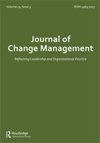管理积极的变化:收购后的情绪和沟通
IF 2.1
Q2 MANAGEMENT
引用次数: 0
摘要
摘要本文以积极的组织学术视角研究变革管理,探讨积极变革管理中情绪与沟通的关系。通过溯因研究,提出了一个积极习得后变化的框架,该框架以积极情绪产生中的互动为中心。该框架建立在2013年底完成的芬兰-德国合并的基础上,并通过2017年初完成的德国-芬兰收购得到证实。基于研究结果,积极情绪可以增强员工对收购后组织的认同,并增加员工对变革的积极性和参与度。相反,负面情绪可能导致保护主义、抵制变革的行为。自上而下的沟通对于确保日常职能至关重要,而互动能够创造积极的情绪,从而使员工参与到与变化一致的行为中。产生积极的情绪,而不仅仅是减轻消极情绪,可以显著提高改变的结果。从业者有能力通过不同的沟通手段鼓励积极情绪的出现。传统的沟通,即“信息共享”,确保了日常的功能,可以帮助减轻担忧,但不能让员工参与变革。相反,参与和互动创造了一种主人翁感,产生了积极的情绪,并激励员工为变革而努力。本文章由计算机程序翻译,如有差异,请以英文原文为准。
Managing Positive Change: Emotions and Communication Following Acquisitions
ABSTRACT This article takes a positive organizational scholarship lens to change management and explores what is the relationship between emotions and communication in managing positive change. Through an abductive study, it suggests a framework of positive post-acquisition change, which centres on interaction in the generation of positive emotions. The framework is built based on a Finnish – German merger completed in late 2013 and substantiated through a German – Finnish acquisition completed in early 2017. Based on the findings, positive emotions can enhance employee identification with the post-acquisition organization as well as increase motivation and engagement in change. Conversely, negative emotions are likely to cause protectionist, change-resistant behaviour. Whereas top-down communication is essential in ensuring day-to-day functions, interaction enables the creation of positive emotions and thereby engages employees in change-congruent behaviour. MAD statement Generating positive emotions rather than merely alleviating negative emotions can significantly enhance change outcomes. Practitioners have the ability to encourage the emergence of positive emotions through different communication means. Traditional communication, i.e. ‘information sharing’, ensures day-to-day functionality and can help alleviate worries, but does not engage employees in change. Instead, participation and interaction create a sense of ownership, generating positive emotions and motivating employees to work toward change.
求助全文
通过发布文献求助,成功后即可免费获取论文全文。
去求助
来源期刊

JOURNAL OF CHANGE MANAGEMENT
MANAGEMENT-
CiteScore
6.60
自引率
20.00%
发文量
14
期刊介绍:
Journal of Change Management is a multidisciplinary and international forum for critical, mainstream and alternative contributions - focusing as much on psychology, ethics, culture and behaviour as on structure and process. JCM is a platform for open and challenging dialogue and a thorough critique of established as well as alternative practices. JCM is aiming to provide all authors with a first decision within six weeks of submission.
 求助内容:
求助内容: 应助结果提醒方式:
应助结果提醒方式:


